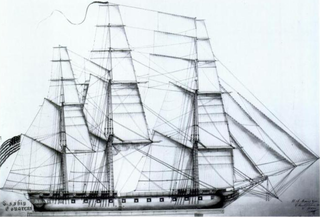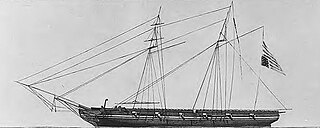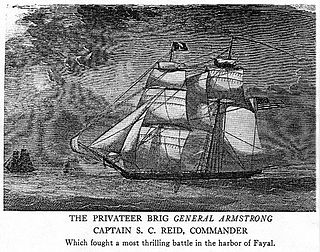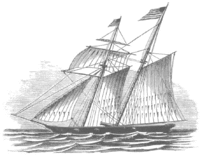
HMS Fantome was an 18-gun brig-sloop of the Royal Navy. She was originally a French privateer brig named Fantôme, which the British captured in 1810 and commissioned into British service. Fantome saw extensive action in the War of 1812 until she was lost in a shipwreck at Prospect, Nova Scotia, near Halifax in 1814.

HMS Belvidera was a Royal Navy 36-gun Apollo-class frigate built in Deptford in 1809. She saw action in the Napoleonic Wars and the War of 1812 and continued a busy career at sea into the middle of the 19th century. In 1846 she was reduced to harbour service, in 1860 she became a receiving ship, and she was finally disposed of in 1906.

HMS San Domingo was a 74-gun third-rate ship of the line of the Royal Navy, launched on 3 March 1809 at Woolwich. She was sold in 1816.

USS Viper – commissioned as USS Ferret – was a brig serving the United States Navy during the early days of the republic. Viper was assigned to enforce the Embargo Act of 1807 along the U.S. East Coast. During the War of 1812, while cruising in the Caribbean, she was captured by the more heavily armed British warships. She then served the Royal Navy as HMS Mohawk until the Navy sold her in 1814. While in British service she served in several actions that earned her crew the Naval General Service Medal,
HMS Highflyer was originally an American privateer schooner built in 1811. As a privateer she took several British vessels as prizes. The Royal Navy captured her in 1813. She then participated in several raids on the Chesapeake and coastal Virginia before the Americans recaptured her later in 1813.
HMS Anaconda was an 18-gun brig-sloop of the Royal Navy during the War of 1812. She was cruising as an American privateer until sailors from HMS Sceptre captured her in 1813. She served briefly in the Royal Navy during the later stages of the War of 1812, especially at the Battle of New Orleans, before being sold in Jamaica in 1815.

HMS Sophie was an 18-gun Cruizer class brig-sloop of the Royal Navy. She served during the Napoleonic Wars and the War of 1812. During the War of 1812 Sophie participated in the economic war against American trade, capturing or destroying numerous small merchant vessels, and in an unsuccessful attack on Fort Bowyer, Alabama. Later, she moved to the East Indies where she served in the First Anglo-Burmese War. The Admiralty sold Sophie in 1825.

HMS Lynx was a 16-gun ship-rigged sloop of the Cormorant class in the Royal Navy, launched in 1794 at Gravesend. In 1795 she was the cause of an international incident when she fired on USRC Eagle. She was at the Battle of Copenhagen in 1801, and during the French Revolutionary and Napoleonic Wars took numerous prizes, mostly merchant vessels but also including some privateers. She was also at the second Battle of Copenhagen in 1807. She was sold in April 1813. She then became the whaler Recovery. She made 12 whaling voyages in the southern whale fishery, the last one ending in 1843, at which time her owner had her broken up.

HMS Mosquidobit was the Chesapeake-built six-gun schooner Lynx that the British Royal Navy captured and took into service in 1813. She was sold into commercial service in 1820 and nothing is known of her subsequent fate.
HMS Shelburne was the American letter of marque schooner Racer, built in Baltimore in 1811 and captured by the British in 1813. She served on the American coast, capturing the American brig Frolic. She also captured some merchantmen and was sold in Britain in 1817.

HMS Dolphin was the 12-gun American privateer schooner Dolphin that Admiral John Borlase Warren's squadron captured on 13 April 1813 and that the Royal Navy took into service. As HMS Dolphin she participated in boat actions on 29 April and 5 May 1813 for which the Admiralty issued a clasp for the Naval General Service Medal. Her ultimate fate is currently undocumented.

The West Indies Squadron, or the West Indies Station, was a United States Navy squadron that operated in the West Indies in the early nineteenth century. It was formed due to the need to suppress piracy in the Caribbean Sea, the Antilles and the Gulf of Mexico region of the Atlantic Ocean. This unit later engaged in the Second Seminole War until being combined with the Home Squadron in 1842. From 1822 to 1826 the squadron was based out of Saint Thomas Island until the Pensacola Naval Yard was constructed.
HMS Nemesis was a 28-gun Enterprise-class sixth-rate frigate of the Royal Navy. The French captured her in 1795 at Smyrna, but in 1796 a squadron led by Barfleur brought her out of the neutral port of Tunis. Throughout her career she served under a number of commanders who would go on to have distinguished careers. She was converted to a troopship in 1812 and was sold in 1814.
The Capture of HMS Dominica was a notable single-ship action that occurred on 5 August 1813 off the Bermudas during the War of 1812. American privateer Decatur and the Royal Navy warship Dominica engaged in a fierce contest that ended with the capture of the British ship after a long battle.

The West Indies Anti-Piracy Operations were a series of military operations and engagements undertaken by the United States Navy against pirates in and around the Antilles. Between 1814 and 1825, the American West Indies Squadron hunted pirates on both sea and land, primarily around Cuba and Puerto Rico. After the capture of Roberto Cofresi in 1825, acts of piracy became rare, and the operation was considered a success, although limited occurrences went on until slightly after the start of the 20th century.

General Armstrong was an American brig built for privateering in the Atlantic Ocean theater of the War of 1812. She was named for Brigadier General John Armstrong, Sr., who fought in the American Revolutionary War.
HMS Colibri was the French naval Curieux-class brig Colibri, launched in 1808, that the British captured in 1809 and took into the Royal Navy under her existing name. She spent her time in British service on the North American station based in Halifax, Nova Scotia. During the War of 1812, Colibri served mostly in blockading the American coast and capturing privateers and merchant ships. She foundered in 1813 in Port Royal Sound, South Carolina, but without loss of life.
William Josephus Stafford (1781–1823), also known as William S. Stafford and Jose Guillermo Estifano, was a sea captain and privateer during the War of 1812 and afterward.

Comet, an American schooner, was built in 1810 at Baltimore, Maryland. She was owned by "a group of wealthy Baltimore investors." Under Captain Thomas Boyle, who was a part owner of the schooner, Comet sailed from July 1812 to March 1814 as a privateer, which was a type of ships licensed by the United States during the War of 1812 to harass the British merchant vessels and divest their cargoes.
Lion was launched in 1803 in Turkey, or 1802 in Spain. British owners acquired her in 1809, probably by purchase of a prize. She was a merchantman and letter of marque. She captured an American privateer in a notable single-ship action in 1813, some months before Lion was wrecked in 1813.














